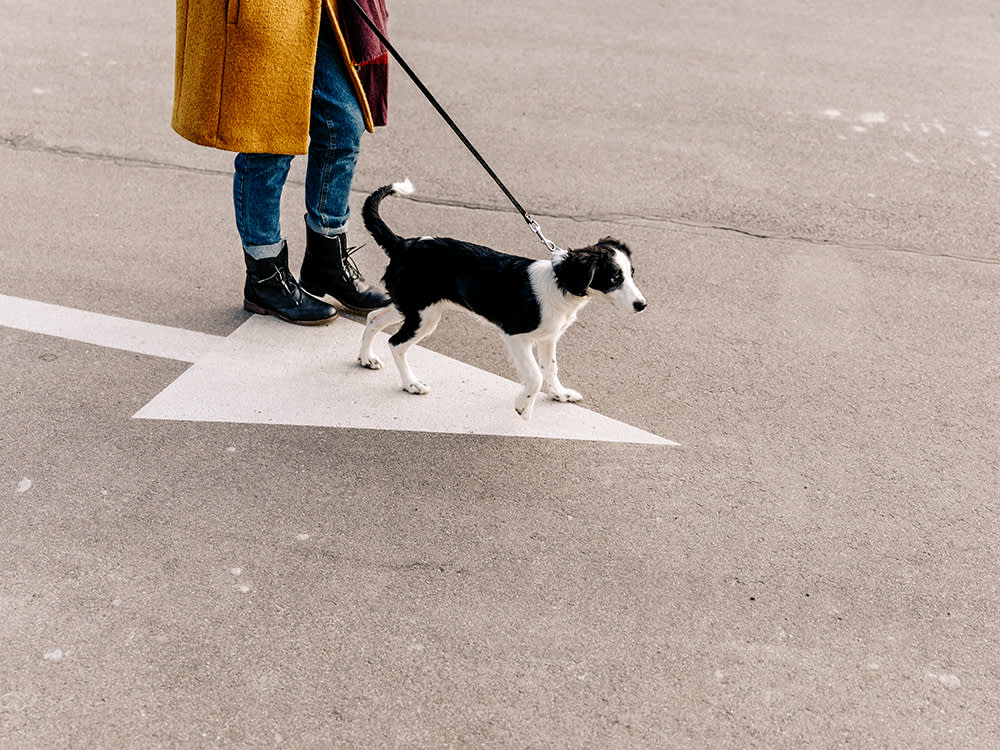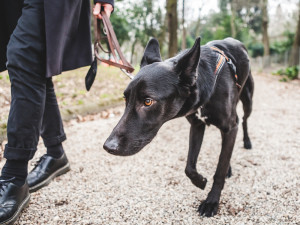How to Leash-Train a Puppy or Dog
Don’t let your new dog walk you.

Share Article
In This Article:
The Basics of Leash-Training a Puppy The Leash-Training Gear You’ll Need Steps to Leash-Train Your Puppy Leash-Training In Different Locations and Seasons The Benefits of Leash-Training Dealing With Common Leash-Training Challenges
Dogs go for walks on leashes. Simple, right? Except for one not-so-minor detail: you have to teach them how to do it. Though it may seem instinctual for some dogs, leash work is a learned skill that usually takes some serious pet parent patience. You’ll want to start early, because a bouncy puppy who pulls, chews, or jumps on strangers might be cute, but an unruly adult dog (yes, even the little ones) is a lot less charming.
We asked Lauren Novack, a dog behaviorist, how to prevent yourself from becoming that person being dragged down the street by their 100-pound Mastiff or tangled up in the leash of their five-pound Chihuahua. Here, her tips on how to get your puppy to walk calmly by your side and what gear to use to accomplish that.
The basics of leash-training a puppy
If you’re feeling overwhelmed by all the to-dos of training a puppy, here’s the good news: “Puppyhood is an excellent opportunity for leash-training since puppies tend to follow their owners around pretty closely already,” Novack says. “You can start as soon as you bring them home.” Leash-training, by definition, just means teaching your dog to walk by your side and check in with you before sniffing out anything else in the environment. (That means no pulling or yanking!)

The main struggle with leash-training is that you’ll be competing with a big, interesting world — filled with squirrels, street pizza, and still more squirrels — for your pet’s attention. “Keep training sessions short and remember to break for playtime,” Novack says. “Think: two-minute bursts of leash-training, break for some play, then repeat for 15 minutes total.”
Wondering how long this whole process is gonna take? “Puppies are really easy and can probably be fully leash-trained in a month,” Novack says, but also cautions to be wary of the “teenage” phase that dogs go through at around nine months old. “When they hit adolescence, they’re going to pretend they’ve never learned anything. Be ready to reinforce training and deal with some boundary pushing.”
The leash-training gear you’ll need
1. A harness over a collar, preferably
“While you can train a dog with just a collar, a harness is safer on their necks — especially growing puppies,” Novack recommends. If you ever notice your dog coughing while pulling on the leash, it’s a good idea to switch to a harness. But if your dog is easily distracted, a head haltie can correct that by literally turning their head toward you when you need them to focus.
2. A four- to six-foot leash
A four- to six-foot leash will give you the most control over your dog. “A retractable leash will teach your dog to pull,” Novack says. And when they pull, they go wherever they want (not what you want). Retractable leashes are also very dangerous, because a dog could dart out into traffic before you have a chance to reel them in.
3. Treats — small ones
“People give dogs treats that are way too big,” Novack says. “Treats should be the size of a pea.” You can even use kibble if your dog is excited by it, and essentially feed them their dinner throughout a training session without any additional calories. The point is: you don’t want them to have to stop to chew and delay the lesson.
If you are not using your dog’s meal as a reward because it is not high enough value, be sure to limit the calories your dog gets over the course of the day. So, if you are training your dog using a lot of yummy treats, you want to give them a little less breakfast or dinner to help your dog from gaining unnecessary weight.
Depending on your dog, you may need to use something much more enticing and smelly than just kibble as a reward. Sometimes, it’s good to mix your dog’s kibble with low sodium turkey hot dogs. That way, you are getting the best of both worlds. When the hot dogs are mixed in with the bag with the kibble, they begin to rub off their smell and flavor on the pieces of kibble, making it a bit more enticing.
The top steps to leash-train your puppy
Step 1: Allow your dog to wear the leash or harness inside to get used to it.
An easy first step before you officially get training is to give our pup a chance to adjust to their new gear. Before you start walking your pup, you can suit them up and let them get used to their leash and harness inside. This will help make their transition to training time a little calmer.
Step 2: Start somewhere safe (and off-leash if possible).
In the ultimate irony, Novack recommends officially beginning leash-training by letting your puppy off leash. “You don’t actually need a leash to teach your dog to pay attention to you and to walk by your side,” she says. Mind-blowing, we know. “The leash should be thought of more like a seatbelt than a primary tool — it’s there to keep your dog safe if an overwhelming stimulus makes them want to chase after it or run into traffic. Basically, the leash shouldn’t be the reason why your dog is by your side.”
But wait — don’t let your pup off leash just anywhere. Pick a location either indoors or in a fenced-in backyard (never anywhere unfenced — and no, invisible fences don’t count) where distractions are minimal. Now it’s time to teach them to walk next to you sans leash…
Step 3: Teach your puppy to stay right by your side, using treats for positive reinforcement.
You do this by training your dog to think that next to your leg is the best place to be. Novack advises “building value” at that sweet spot by holding a treat there — right where your pup would be when you’re walking them. Without reaching out or prompting your puppy by touching your leg, let them come to the side of your leg to take it. Once you’ve mastered that, slowly take steps forward, treating your pet continuously as you walk, again making sure you’re doling out the treats right at your leg.
Once they comprehend that being by your side equals treats, stop holding the treat there the whole time. Instead, take a step forward and wait for your pup to follow suit before treating them. You can then take more and more steps forward — two, 10, and so on — before they get a treat.
Step 4: Transition from indoor to outdoor environments.
At some point in the process of teaching your pup to stay by your side, layer in a leash so you can take them outside, challenging your pup to stay focused when there are distractions (squirrels) around.
Step 5: Relax the leash and let the real world be their reward.
One you’ve got your pup sticking by your side without a steady flow of treats, it’s time to literally loosen the leash. You might come up with a verbal cue to let your dog know it’s okay to explore. Say there’s a pee spot they love to sniff — if they’re loosely by your side and look up to check in with you, you can say, “Okay, go sniff,” and they’ll know they have the green light to leave your side.
Just be sure not to start moving where they pull you. “What you want them to learn is that the fastest, easiest way to get what they want is by staying loosely by your side,” Novack says. “Pulling shouldn’t get them anywhere.”
Leash-training in different locations and seasons
Some other factors to consider when leash-training your puppy are location and season. While “leash-training a dog uses the same basic tools wherever you are, people in the city often have to be way more on top of their training,” Novack says. “In a city as big as New York City, for example, a simple pee break could involve an untold number of distractions. Meanwhile, if you have a backyard in the suburbs, your dog may go on fewer walks and a less-than-perfect heel is no big deal.
“It’s important for dogs to be acclimated to all weather conditions,” adds Novack. “But if you live where there are extreme weather conditions for much of the year, a few extra pieces of gear may help.” A coat can help keep your dog warm in frigid temperatures, and booties will protect their paws from the salt that melts snow.” She also recommends treat tubes — squeeze tubes in flavors like peanut butter — which are easier to use when you’re wearing gloves.
Differences between leash-training puppies and older dogs
While both puppies and older dogs can be trained to walk on a leash, there are some differences between teaching young and old dogs.
Energy levels
Puppies typically have higher energy levels than senior pups — and their attention spans are probably shorter. When training a puppy, you may want to train in short, enthusiastic bursts and provide lots of breaks. A senior dog is likely calmer and able to handle a longer training session, but those sessions should be slower paced to match their energy level.
Habits
Unlike puppies, senior dogs may have already established some undesired habits. It may require more patience, consistency, and time to teach a senior dog a new way to behave. Don’t lose hope, and never punish your pup. Use positive reinforcement to reward a senior dog for go
od behavior.
The benefits of leash-training
There are plenty of great reasons to leash-train your pup — for both pets and pet parents.
Safety: When your pup knows how to stay close to you on a leash, you’re both able to walk stress-free and remain aware of your surroundings.
Bonding: Leash-training helps pups bond to pet parents and improves trust.
Health: When walks are calm and easy, it incentivizes pups and pet parents alike to go out strolling, which improves your dog’s — and your — mental and physical health.
Should I train my dog to walk off leash?
Though dogs should be leashed when out in public in most situations for their safety, it’s important for your dog to know how to walk off leash. This will allow them to stay by your side and respond to your cues in case of an emergency or in an off-leash situation such as a yard or dog park.
Dealing with common leash-training challenges
Leash-training isn’t always straight-forward, and a few challenges may arise.
How to address pulling
If your dog pulls, avoid pulling back against them — and definitely avoid following their pull. “Allowing a dog to pull and following them with tension on the leash just reinforces pulling. The dog learns that pressure on the neck means forward movement, which is what’s motivating their behavior,” dog trainer Robert Haussmann told us. “In other words: your dog wants to move forward, and if you move them forward when they pull, they’re gonna want to keep pulling.”
You may want to try a new piece of equipment, such as a no-pull harness. “That’s a harness where the leash attaches in front of the dog on the chest area, which is right in front of the dog’s center of gravity,” Haussmann explains. “When the dog goes to pull forward, they can’t as easily engage the pressure on the leash and pull you.”
How to handle distractions and interruptions
You’ll want your dog to have a strong handle on leash-training before they encounter distractions, that way they know what is expected of them when the time comes. You can build to larger and larger distractions as you train. Use plenty of treats and positive reinforcement training to remind your pup which behavior is desirable.
How to handle leash reactivity
If your pup is reactive on a leash, you should leash-train them away from stimulation and slowly incorporate more and more stimulation while using positive reinforcement training. For example, you can ask a friend to walk their dog on the other side of the street; if your pup ignores the dog or reacts without fear or excitement, you can reward your dog with a treat. Then, you can try again with the friend’s dog coming a bit closer. Don’t rush your dog; this may be a slow process.
FAQs (People also ask):
How often should I have leash-training sessions with my dog?
Ideally, you should practice leash-training daily. Puppies may like to have several short, intense sessions throughout the day, while seniors may like a longer and calmer session.
What should I do if my dog doesn’t like to wear a collar or leash?
Your dog may react better to a different kind of collar or harness. You can use treats to train your pup to associate the collar or leash with a positive event.
What are common leash-training cues?
You will want to teach your dog some common training cues such as “stay,” “sit,” and “come” to help them learn how to behave on a leash.
References:

Colleen Stinchcombe
Colleen Stinchcombe lives near Seattle, WA, where she works as a writer, editor, and content strategist. Her two rescue pups wish she were a professional ball-thrower.
Related articles
![Man in park struggling to hold his Pitbull dog who is pulling on a leash]()
“How Do I Get My Dog to Stop Pulling on the Leash?”
Dog trainer Robert Haussmann’s tips for turning a stressful walk into a chill stroll.
![Man holds his Labrador dog in his arms outside.]()
You Raise Your Dog the Way Your Parents Raised You, New Study Finds
One more thing to talk about with your therapist.
![The yellow bandana is part of a new international movement for reactive dogs.
Dogs wearing yellow are often signalling that they need space and could become reactive if approached by another person or off-leash dog.]()
Vancouver Is Giving Out Yellow Bandanas to Reactive Dogs to Signal Their Need for Space
Not all dogs like to be approached—The Yellow Bandana Project is trying to help communicate their needs.
How Long Can You Leave a Dog Alone?
Not that you want to be away from them anyway.
![Shy black dog walking with owner at the park.]()
How to Help an Anxious Dog Conquer Their Fears
Pro tips for boosting the confidence of a scaredy-cat dog.
Are Dogs Actually Stubborn?
“Labeling a dog as stubborn is often an easy way to shift the blame from a problem with the relationship to a problem with the dog.”









